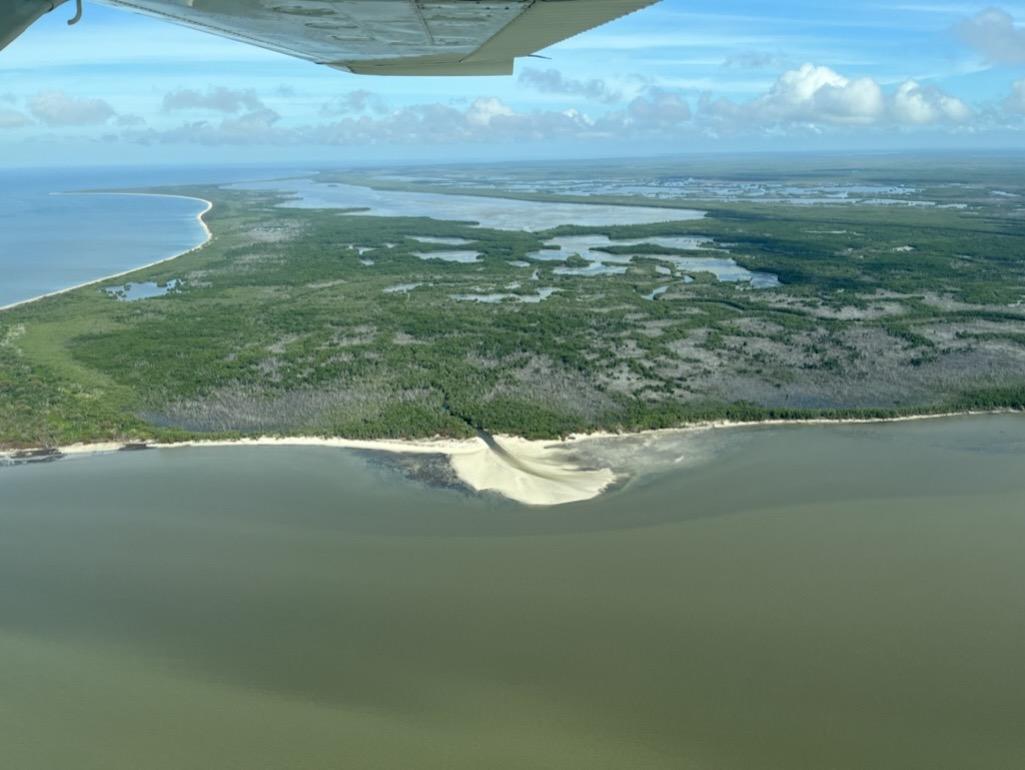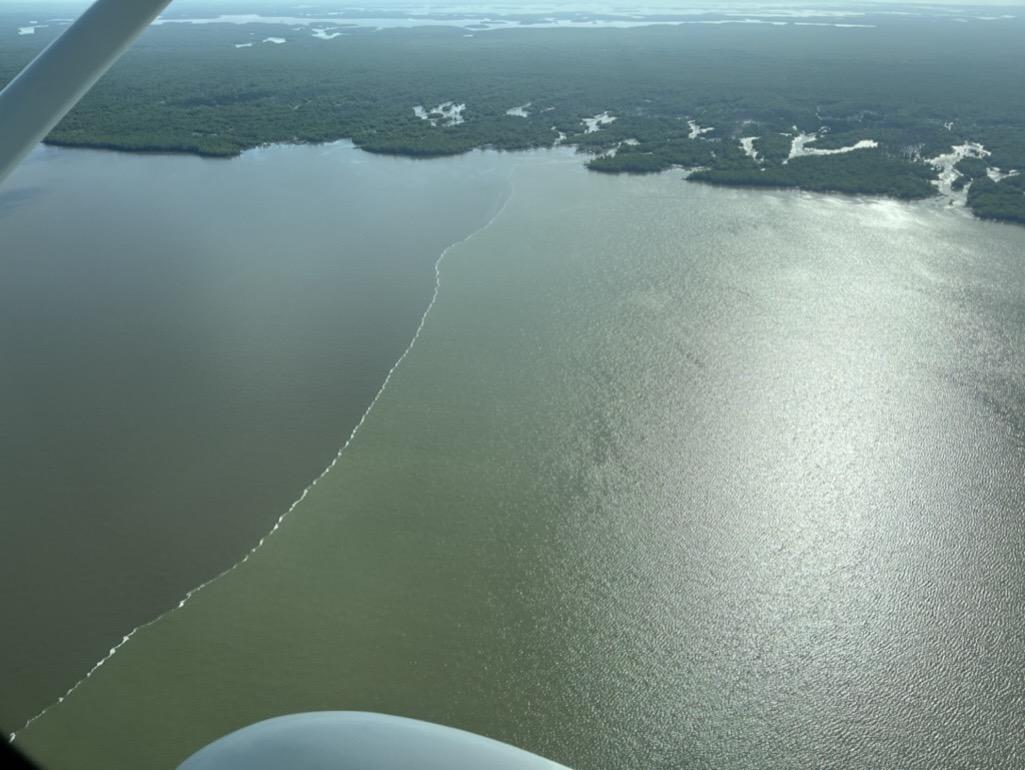
The storm surge from Hurricane Ian caused a new delta to form near East Cape Sable at Everglades National Park/Steve Davis
Hurricane season so far has been kind to Everglades National Park, and not just because storms didn't deliver any direct hits to the park.
Hurricane Ian spared the park, swirling largely to the west and north of Everglades, and Tropical Storm Nicole seems on track this week to avoid the national park as well. So while it doesn't appear likely the park will incur a battering such as those delivered in 2017 by hurricanes Irma and Maria, there are benefits these glancing storms can bring.
"There are benefits, and it's how you sort of look at those benefits in time, where it becomes clear," said Dr. Steve Davis, the chief science officer for The Everglades Foundation, during an interview in mid-October. "Obviously, you know, stripping leaves off trees like mangroves that are evergreen, that obviously requires quite a bit of energy to recover from. Scouring of seagrasses also can be a very bad thing because it takes a while for those grasses to recover. But at the same time, in places like Florida Bay, you get some of the basins out there that don't flush very well. And so hurricanes, and in the case of Ian, it appears as though we saw pretty substantial flushing of some of the basins that were still showing the signs of impact from seagrass die off seven years ago, and algae blooms were reaching their peak."
While Ian moved around the park, the intensity of that hurricane created an unusually high storm surge. Surges can be like water sloshing about in a wash pan, coming in as large wave, and then reversing course and pulling out the water. At the national park, a particularly high storm surge was noticed on the southwestern edges of Everglades.
"The storm surge was probably the most significant and widespread effect, with surges ranging from around 2 feet in Key Largo to around 7 feet in Everglades City," said Allyson Gantt, the park's spokesperson. "The timing of the surge will likely cause different effects on the ecosystem than we saw during Hurricane Irma because the peak surges occurred after the strongest winds and rain had ended. This may result in greater saltwater intrusion into freshwater areas at some locations, and we're still assessing those effects."
After the hurricane passed, Davis took to the air to see what impacts Ian had on the national park and Florida Bay specifically. During that flight he was able to see the bay's seabed in places and patches of seagrass. The retreating storm surge had broken up and pushed out a lot of algal growth that had resulted from decaying seagrass. Davis explained that the decaying nutrients release a lot of phosphorous. The Gulf of Mexico naturally generates phosphorous, he said, and normally the seagrass takes it up. But when there's a massive die-off of seagrass, that phosphorous is released. Benefitting from that release is blue-green algae.
"You couldn't see [the bay's seabed] from a boat on the water prior to the storm because the water was so murky and looked like pea soup," the scientist said. "So I think there's been a good flushing effect on some of those basins. From that standpoint, yes, absolutely a positive. Whether that sustains itself remains to be seen, but there is some temporary relief in terms of water quality out there."
That cleansing surge does seem to have been short-lived, according to Gantt.
"Over the recent weeks, we've seen the blooms again intensifying in many of the areas where the algae was, and recent satellite imagery suggests that the bloom may now be both larger and more intense than before the storm," she said in an email. "We may continue to see the bloom shift and change in coming weeks, so it's still premature to say that the storm either improved or worsened the bloom."
Another benefit was the huge amount of rain -- 15-18 inches in some places -- that fell north of the park, over the headwaters of Lake Okeechobee that feeds the "river of grass" as it flows south through Florida and into Florida Bay.
"The water levels upstream were surprisingly low for this time of year, and we were concerned that this could lead to drought conditions and low flows to Florida Bay later in the dry season that could be harmful," Gantt said. "The rains from Ian have significantly reduced the chances that we'll have significant impacts from lack of water in the upcoming dry season."

A tannin-colored plume of freshwater flowing out of Shark River Slough and southward toward Cape Sable/Steve Davis
Davis said that recent hurricanes have brought very beneficial rainfalls to the Everglades, and that has helped everything from wading birds and waterfowl to fisheries in Florida Bay.
"With Irma [in 2017], we had the system set up perfectly for both really epic fisheries production in the mangrove creeks. With that freshwater outflow, you get optimal estuarine conditions, and so sport fishes like snook and spotted seatrout, redfish, all documented highs for the period of record. What they saw with the young of year crop of fisheries was really positive," he said. "At the same time, that high rainfall also coincided with a near perfect recession of water through the following dry season that led to record wading bird nesting in 2018. So that again, it's a direct result of the rainfall provided by Irma that year.
"I don't know if we got enough rainfall with Ian to have the same level of benefit. Part of it will depend on what the dry season looks like," the scientist added. "But we were in a mild drought prior to Hurricane Ian and so we know that the rainfall is welcome and will deliver some benefit. It will make the situation better than it would have been. But I don't think it's going to be as epic as as the benefits of Irma, and a lot of that just depends on pre-existing conditions, as well as how things recede throughout the dry season."
Beyond the increased water flows spurred by Ian, the storm did some damage to the coral reefs around Dry Tortugas National Park. Gantt said crews were inspecting the reefs and would repair any damage inflicted on them if possible.
"At Dry Tortugas, wind impacts were more significant - trees were downed and largely defoliated," the park spokesperson said. "There was a lot of sand movement and shoreline change at Dry Tortugas that occurred, too, and this affected some of the important wildlife habitats at the site, including sea turtle nesting beaches, the vegetation that supports the large sooty tern colony, and the black mangroves that support magnificent frigatebird nesting. "
Despite the impacts to Everglades, Davis didn't think hurricanes were changing the park's ecosystems.
"We do know that there are lasting effects when when you have a storm like Hurricane Irma that knocks out a patch of forest over the course of 5-10 years where you see that delayed mortality. You wonder if that's going to be revegetated or if those soils are going to sink to the point where it becomes open water and, and that really is emblematic of the history of the Everglades," he said. "It's a fairly young ecosystem and we know that these kinds of of dramatic transformations take place."
While Irma's storm surge led to the dieback of mangroves across roughly 26,600 acres of the Everglades, Davis didn't find that highly unusual.
"It fits within the realm of what's happened historically; I don't see that as being a major change. We do know with sea level rise, combined with reduced freshwater flow, that allows surge in some areas to penetrate even deeper into the Everglades. And so just over my history here in South Florida, I've seen mangroves and they're largely pushed up with storm surges. I've seen mangroves become established in places like Mahogany Hammock where there were no signs of mangroves around Mahogany Hammock. It's a freshwater system, and it still is a freshwater system but you do see mangroves growing around it today."
That's why Everglades restoration, a long-term, multi-billion-dollar effort, is so important to the ecosystem, explained Davis. Currently, infrastructure has so impeded natural water flows south from Lake Okeechobee that only 40-50 percent of the water that historically moved through the river of grass is reaching Florida Bay, he said. Without that push of freshwater, mangroves, which thrive in brackish and saltwater, are able to move further inland.
"There are some areas around the panhandle of the park on the eastern side near U.S. 1 where the mangroves over the last 20-30 years have really migrated ever landward up to the point where they're up against canal structures now and levees," he said. "So those kinds of changes have taken place. They're facilitated to some extent by storms, but we also know that reduced freshwater flow and sea level rise are kind of long-term pressures that help to drive those transformations."



Add comment